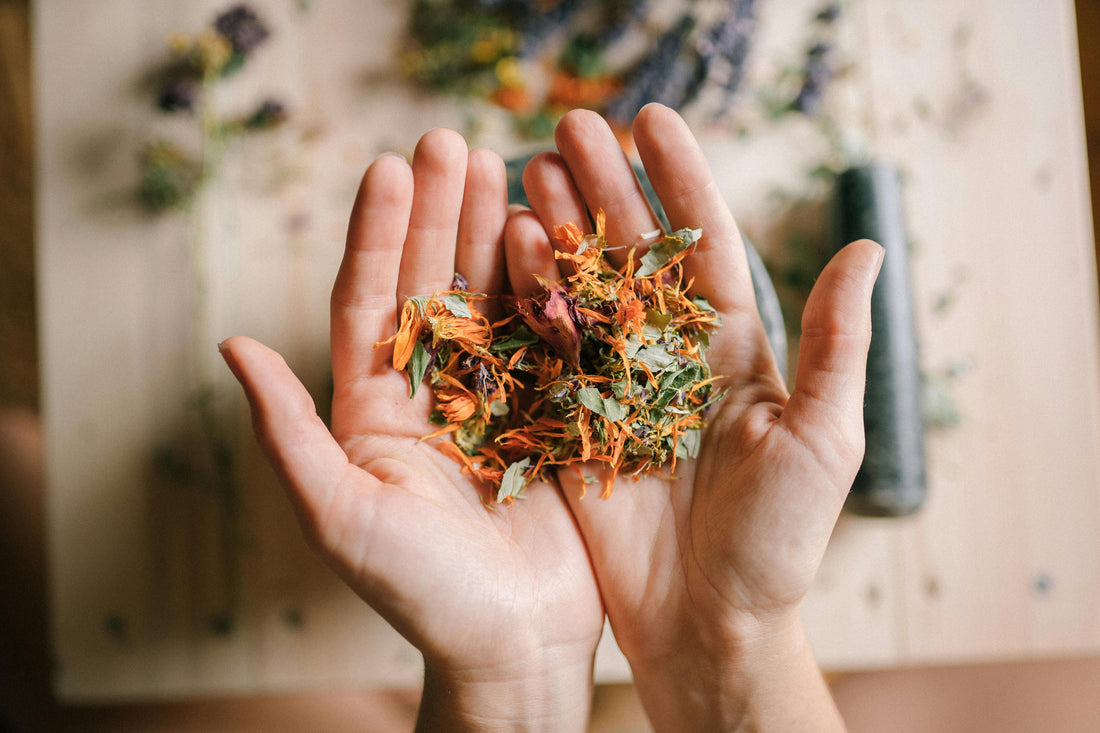
Unlocking the Flavor Power of Herbs and Spices: A Beginner’s Guide
Share
If you’ve ever stared at your spice rack and felt overwhelmed, you’re not alone. The world of herbs and spices can feel intimidating, especially for home cooks who want to create flavorful meals but don’t know where to start. The good news? Once you learn a few basics you’ll understand the essentials behind the most popular seasoning blends, when to use fresh or dried, and the best combinations for specific dishes like fish, meat, veggies, and more.
Why Seasoning Matters
Seasoning isn’t just about making food taste better—it’s about enhancing natural flavors, creating balance, and adding depth to every bite. The right combination of herbs and spices can turn a bland dish into a masterpiece, making ingredients shine without overpowering them. How different flavors interact is the key to building complexity in your cooking, whether you’re aiming for subtle elegance or bold, vibrant tastes.
What’s the Difference Between an Herb and a Spice?
First, let’s clarify the distinction between herbs and spices - a common source of confusion. Herbs are the leafy, green parts of plants like basil, parsley, and cilantro. They’re often used fresh but are also available dried. Spices, on the other hand, come from other parts of the plant, such as seeds (cumin), bark (cinnamon), roots (ginger), or fruits (paprika). Both herbs and spices bring unique flavors to your dishes and understanding when to use each can elevate your cooking.
When to Use Fresh Herbs vs. Dried Herbs vs. Spices
The choice between fresh and dried herbs or spices depends on the dish you’re making and the flavor profile you’re after. Fresh herbs are ideal for adding bright, delicate flavors and are often used as a garnish or stirred in at the end of cooking. Think of fresh basil on a margherita pizza or cilantro sprinkled over tacos.
 Dried herbs and spices, on the other hand, are more concentrated and robust. They shine in dishes that require longer cooking times, such as soups, stews, or roasts. For example, dried oregano and thyme are staples in Italian sauces and roasts because their flavors deepen with heat and time. Owing to their more concentrated flavor, dried seasonings are often used to quickly add flavor to any meal.
Dried herbs and spices, on the other hand, are more concentrated and robust. They shine in dishes that require longer cooking times, such as soups, stews, or roasts. For example, dried oregano and thyme are staples in Italian sauces and roasts because their flavors deepen with heat and time. Owing to their more concentrated flavor, dried seasonings are often used to quickly add flavor to any meal.
Fresh Herbs
Fresh herbs work best in recipes where their delicate flavors won’t be lost. They’re great for:
- Salads and dressings: Fresh basil, cilantro, and parsley brighten up greens and vinaigrettes.
- Pasta and grain dishes: Stirring in fresh oregano or dill at the end of cooking enhances freshness.
- Cold dishes: Think fresh mint in yogurt sauces or fresh chives on deviled eggs.
- Quick-cooking meals: Fresh tarragon or basil works well in light sautés, omelets, or fresh tomato sauces.
Dried Herbs

Dried herbs are the quickest and most convenient way to add robust flavor to any main or side dish. They are also preferred in recipes that simmer or roast for extended periods that allow their flavors to develop for such uses as:
- Soups and stews: Dried thyme, oregano, and bay leaves add depth over time.
- Roasted meats and vegetables: Dried rosemary, sage, and cumin withstand high heat.
- Salad dressings and dips: Dried oregano, basil, and dill are excellent in vinaigrettes, yogurt-based dips, and marinades.
- Egg dishes: Sprinkle dried chives, parsley, or paprika on scrambled eggs, omelets, or frittatas for extra flavor.
- Baked goods: Dried cinnamon, nutmeg, and cloves provide consistent spice in breads and desserts.
- Finishing touches: Some dried herbs, like thyme and oregano, can be crumbled over dishes just before serving for an extra punch of flavor.

Dried Spices
Dried spices play a crucial role in building deep, complex flavors. Unlike herbs, which tend to have a fresher, more delicate taste, spices provide warmth, earthiness, and intensity. Dried spices are every home cook’s go-to for flavoring or punching up meals and snacks, infusing flavor in dishes, and adding depth to baked goods in the following ways:
Providing bold seasoning: Spices shine in dry applications where fresh herbs might wilt or lose potency, such as:
- Spice rubs for meats
- Roasted vegetables
- Slow-cooked stews
- Seasoning for snacks like popcorn or roasted nuts.
Infusing flavor: Dry spices dissolve well in liquids, making them excellent for infusing an entire dish with their essence, think:
- Soups and stews
- Casseroles
- Marinades
- Braised dishes
Adding depth: Additionally, ground spices are a must-have for baked goods. When baking, it's best to toast whole spices before grinding them to bring out their full aroma and flavor.
- Sweets – cinnamon rolls, pumpkin pie
- Savory breads – sesame rolls, spicy corn bread
Spice Blending 101

Blending herbs and spices is about balance. Here are a few proven principles the experts use for combining these seasonings in a way that enhances the natural flavors of ingredients without overpowering them.
Start Simple: Build a flavor base using two or three complementary herbs and spices. For example, garlic powder, paprika, and thyme create a versatile seasoning blend for roasted chicken.
Layer Flavors: Use a mix of aromatic spices (like cumin or coriander), sweet spices (like cinnamon or nutmeg), and heat (like chili powder or cayenne) to build complexity.
Know the Cuisine: Different cuisines have certain basic signature herb and spice combinations that deliver on a given flavor profile. For instance, basil, oregano, and rosemary for Italian dishes or cumin, coriander, and chili powder for Mexican food.
The Most Popular Seasoning Blends for Everyday Cooking
There’s a reason why the most popular seasoning blends are just that – popular. They follow the basic guidelines outlined above in order to skillfully deliver on the desired flavor profile.
What Are the Best Spices to Put on Fish?
Fish has a delicate flavor that benefits from light, aromatic seasonings. Here are some ideas:
- Basic Fish Seasoning: A simple blend of salt, black pepper, garlic powder, and paprika.
- Good Seasoning for White Fish: Lemon zest, dill, and a pinch of cayenne.
- Italian Seasoning for Baked or Grilled Fish: Basil, oregano, parsley, and thyme.

What Are the Most Popular Seasoning Blends for Meat?
When seasoning meat, focus on creating layers of flavor that enhance its richness.
- Butcher Spices for Beef: A classic butcher’s spice mix might include black pepper, garlic powder, onion powder, and paprika.
- When making a BBQ Seasoning Blend for Ribs or Chicken shoot for a sweet and smoky flavor: Brown sugar, smoked paprika, black pepper, and rosemary.
- A Classic Butcher’s Seasoning for Pork or Roasts includes: Rosemary, parsley, and mint.
What Are the Best Spices for Veggies?
Vegetables are a blank canvas for creative seasoning. Certain combinations of herbs and spices can elevate both the flavor and health benefits of vegetable dishes.
- Roasted Veggie Seasonings: garlic powder, dill, tarragon and thyme.
- Healthy Spices to Cook with: turmeric and cumin add an earthy flavor and anti-inflammatory boost to grilled or roasted vegetables.
- Unique Seasoning Blends for Veggies: for instance, a mix of thyme, oregano, marjoram or a combination of the three, along with other spices including sesame, sumac, cumin or coriander impart a traditional Middle Eastern-inspired flavor.
What Spices Impart South-of-the-Border Flavor?
Mexican cuisine is known for bold, spicy flavors. Here are some staple combinations that evoke that distinctive taste:
- Fiesta Blend Seasoning: A versatile mix of cumin, chili powder, garlic, and oregano works for tacos, enchiladas, or fajitas.
- Best Spices for Heat: Cayenne, chipotle powder, and paprika add smoky, spicy notes to dishes.

What Are the Best Herbs and Spices for Italian Food Flavor?
Italian cuisine relies heavily on herbs like basil and oregano:
- Herbs Used in Italian Seasoning: Basil, oregano, rosemary, thyme, and marjoram create the signature Italian flavor.
- Spices for Italian Food: Starting with a base of garlic powder, onion powder, and crushed red pepper bring depth to pasta sauces and pizza.
- Unique Seasoning Blends: Add a pinch of nutmeg to creamy sauces for a subtle, warming flavor.
Play with Your Food!
Blending herbs and spices is both an art and a science. Combining seasonings just right might feel daunting at first, but it just takes a bit of trial and error. If you’re making your own, start with a few simple blends and expand your flavor horizons over time. Another option that takes the guesswork out of seasoning is to try premade spice blends with expertly curated flavor profiles in just the right balance. Remember, part of the fun is exploring different flavor combinations. The best seasoning isn’t about following rigid rules—it’s about experimenting, tasting, and discovering what makes your taste buds happy.

